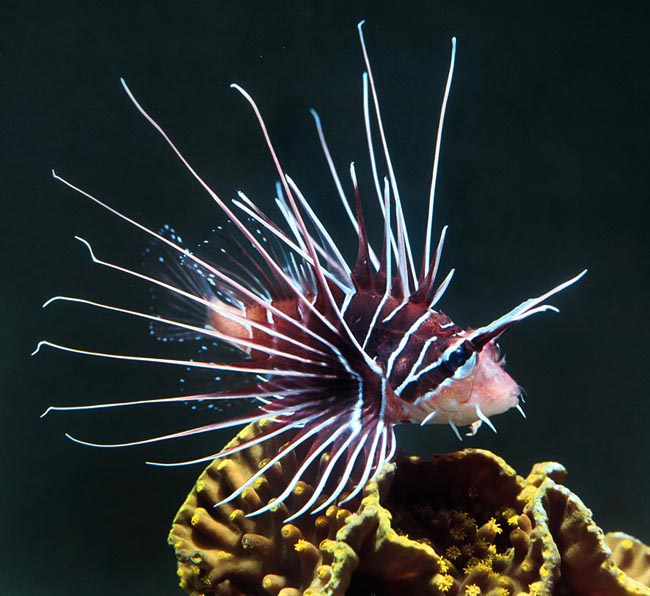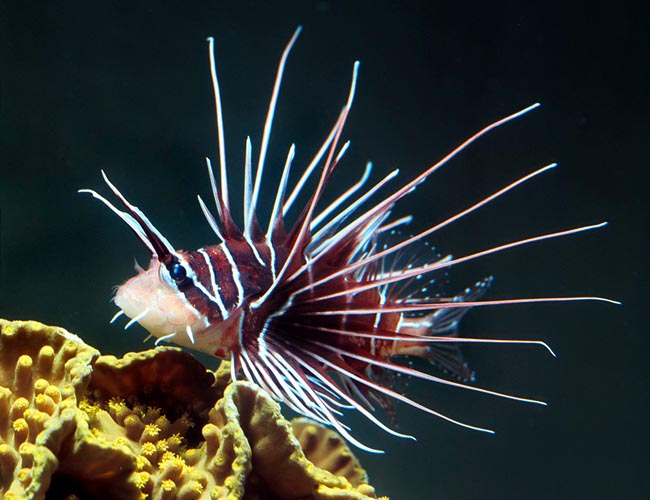Family : Scorpaenidae

Text © Giuseppe Mazza

English translation by Mario Beltramini

Pterois radiata is quite rare, with very vast diffusion in the Indo-Pacific © Giuseppe Mazza
The name of the genus comes from the Greek “pteron” = wing, feather, with reference to the fins, similar to feathers.
The name of the species comes from the Latin “radiatus” = equipped with rays, with reference to the pyrotechnical filiform fins.
The Italian name of “cobra” reminds us, on the contrary, the powerful poison present in the spiny rays of the fins.
Zoogeography
It is an uncommon species, but with a vast diffusion in the tropical waters of the Indian and Pacific oceans. We find it, indicatively, along the whole African coast, from South Africa to the Red Sea and the Gulf of Aden, at the Seychelles, Mauritius and Maldives Islands, in India, Sri Lanka, Christmas Island, Australia, Indonesia, Micronesia, New Guinea, New Caledonia, Philippines, Taiwan and in the Ryukyu Islands in southern Japan. Southwards, it reaches New Caledonia, eastwards, the Tonga, Samoa, Kiribati, Tahiti and Hawaii Islands.
Ecology-Habitat
The radial firefish goes down up to about 30 m of depth, preferring to the madreporic formations the rocks rich of crevices where it rests, before the night hunting, often hidden head down.
Morpho-physiology
Smaller than Pterois volitans it reaches the 24 cm at the most. Like this one, it has a massive head, but the dorsal fin and pectoral ones have unmistakable white filiform rays even longer than the body. To be precise, the dorsal fin has 12-13 spiny rays connected to relevant poison glands and 10-12 soft rays; the anal has 3 spiny rays, poisonous too, and 5-6 soft, whilst the ventral ones do not have spines, as well as the showy rayed pectoral ones and the rounded caudal.

Unmistakeable for the fins long rays and the horizontal white marks on the caudal peduncle © Giuseppe Mazza
For hunting, this species does not utilize the poison, which is kept as a defence weapon, but it surprises the preys with the rays opened like a fan which hinder the escape and sucks up them thanks to its enormous protractile mouth, holding them with the tiny teeth.
On the contrary, the spines are used when it is attacked, often in extremis, into the mouth of the predators which hasten to spit it out.
The bites, apart the pain, cause in the man nausea, vomiting, dizziness, fainting, difficulty in breathing, drop in blood pressure, seizures and in some instances also heart failure.
It is matter, as is the case for the Pterois volitans, of a toxin which is thermolabile at 50-60 °C and as first aid, when possible, it is suggested to immerse the affected part in warm water.
Ethology-Reproductive Biology
The radial firefish nourishes mainly of crabs and shrimps. It is a solitary species which reaches, in aquarium, the 10 years of life. Not much is known about its reproduction, apart the fact the fecundated eggs originate pelagic larvae dispersed by the currents.
Seen the modest size, unlike the Pterois volitans it is not fished for alimentary purposes and the populations decimated by the events double more rapidly, in only 1,4-4,4 years. Ironically, therefore, even if rare, it has a lower vulnerability index, of 36 on a scale of 100, against the 57 on 100 of the other species.
Synonyms
Pteropterus radiata Cuvier, 1829.
→ For general information about fishes please click here.
